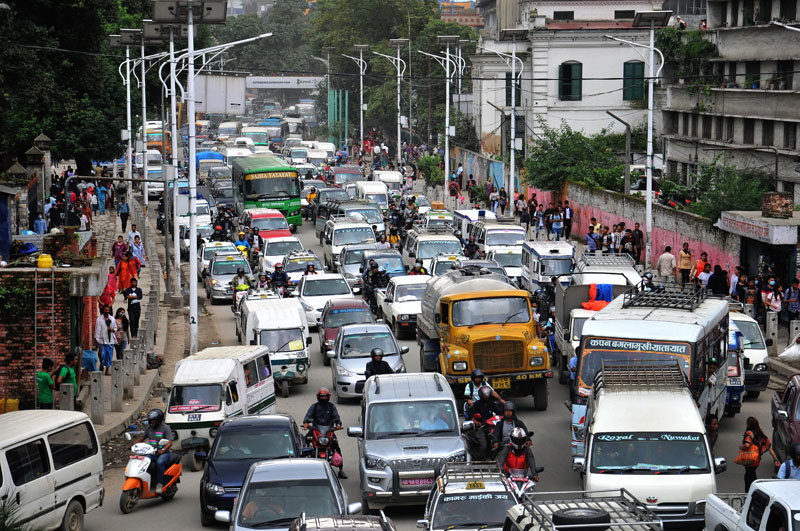How rational is the government’s decision to phase out 20-year-old public vehicles?
- Some believe government should put a ban on public vehicles on the basis of vehicular emissions instead of age if the pollution is to be actually controlled
Kathmandu, February 16
With an ambitious target to control city pollution and manage public transportation system in the country, the government is all set to put a ban on public vehicles older than 20 years from February 28. However, the effectiveness of the ban and whether the move would help achieve the main objective — to improve the environment — is debatable.
In the offing
The Department of Transport Management (DoTM) — the transportation sector regulatory body — has prepared a directive to implement the new rule on old public vehicles strictly.
The government had published a notice in Nepal Gazette on March 1, 2015, directing transport entrepreneurs not to operate 20-year-old vehicles effective from February 28. However, DoTM suspects that a huge number of such old vehicles are still plying the roads. As a result, the DoTM plans to aggressively monitor the transportation sector after February 28 and phase out all old public vehicles.
“We have formed a separate committee to carry out inspection in the market after February 28 and all regional offices of DoTM have been directed to carry out intensive monitoring and prohibit such outdated vehicles from plying the roads,” informed Tok Raj Pandey, spokesperson for DoTM.
DoTM believes that such old public vehicles are the major cause for the rise in air pollution and deteriorating beauty of the urban areas. According to DoTM, there are around 5,000 vehicles that have crossed the 20-year mark in the country. Of them, almost 2,500 are plying on Kathmandu Valley roads and phasing out these public vehicles is also expected to ease traffic congestion in the Capital, according to Pandey.
Not enough homework
However, implementing the ban may not be as easy as it sounds.
Automobile dealers, for one, believe that the government has not done enough groundwork to implement the ban in the first place.
“The intention for implementing the ban is undoubtedly good. However, the decision on whether or not to ban a vehicle should be based on its road-worthiness. And for that, the government should bring high-tech mechanism to check the technical conditions of the vehicles,” said Shambhu Dahal, vice president of Nepal Automobile Dealers’ Association (NADA).
Echoing that sentiment, Dol Nath Khanal, president of the Federation of Nepalese National Transport Entrepreneurs Association, said, “Just because a vehicle is over 20-years-old doesn’t mean it is unfit to be driven. The government should first introduce a system of international standards to determine the road-worthiness of vehicles,” Khanal said.
Even government officials, depending on which state agency they are employed with, seem divided on the matter.
For instance, Durga Prasad Dawadi, director general of the Department of Environment (DoE), believes that the government should put a ban on public vehicles on the basis of vehicular emissions instead of age if the pollution is to be actually controlled.
“As harmful vehicular emission is the major contributor to air pollution in the country, the government should establish better systems to check the quality of smoke emitted from vehicles and prohibit vehicles found to be releasing toxic fumes from plying the roads,” Dawadi said.
But DoTM Spokesperson Pandey expressed confidence that none of the public vehicles above 20-years of age from their manufacturing date plying on Nepali roads is technically sound to be operated.
Investment at risk
Also overlooked in the government’s decision to ban the old vehicles is the investment made by the transport entrepreneurs.
According to Khanal, the government should come up with a scheme to compensate the affected transport entrepreneurs before putting a ban on their vehicles. Implementing a ban on old vehicles without providing any subsidy to the vehicle owners will put substantial investments of transport entrepreneurs at risk, he said.
However, according to Pandey, the transport entrepreneurs should bear the cost of replacing their old vehicles themselves and the government has no plans of introducing any kind of compensation for the affected transporters.
Meanwhile, NADA Vice President Dahal sees little relevance of the new rule. “Often, transporters themselves sell their vehicles to the scrap yard after they cross 12 to 15 years of operation as such old vehicles invite high maintenance cost and are not cost effective for transporters.”
Also to be noted is that almost 50 per cent of government-owned vehicles have crossed the 20-year mark. “Rather than banning vehicles simply looking at their manufacturing date, it would be more effective if all government agencies worked together and developed execution capacity to reduce vehicular pollution in the country,” said DoE’s Dawadi.






